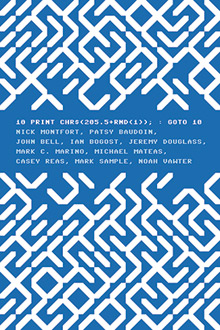When Nick Montfort, associate professor of digital media at MIT, brought his trusty Commodore 64 on a recent trip to the West Coast, he got extra attention from airport security staffers. As he wrote in his blog:

By Nick Montfort et al.
MIT Press, 2013, $30
Seattle: “No, for real?” “Yes for real.” “That was my first computer!” “How old is that thing?” “It’s from 1982.” “Hey, that used to be state of the art! But now—[TSA agent takes phone out of pocket, points to it.] “This has got more processing power!”
Los Angeles: “Sir, please come with me.” [TSA agent swabs power supply for explosives.] “Can you tell me what this is for?” “It’s a computer.” [Older TSA agent arrives.] “Hey! A Commodore 64! That’s a classic!”
Though Montfort has access to more modern technology, he is still devoted to the taupe-colored relic, both for what it can do and for what it has meant. In a new book with nine coauthors, 10 PRINT CHR$(205.5+RND(1)); : GOTO 10, he reflects on the Commodore 64’s influence on code and culture since its debut in the early 1980s, when it allowed the masses to tinker with programming at home. “The Commodore 64 is remarkable in that it gives immediate access to the ordinary user to be able to program the computer,” says Montfort. “It’s not better than the current computers … but if you wanted to turn on a switch, type in a one-line program, run it, and start modifying it, you can start to explore what a computer can do within a minute, and that’s very compelling.”
The unwieldy book title is a single line of well-known BASIC code that produces a continuous, maze-like pattern of diagonal lines when run on a Commodore 64. To the authors, it is a text to be studied much as a line of poetry might be. Part of their exploration involved creating alternative versions of the program and “porting” it to run on other computers. “By doing this work, we map the space of possibilities—what else could have been written that was similar to this program?—and we also understand more about the process that led to the creation of this program and programs like it,” Montfort says.
Chapters in the book discuss the significance of mazes in literature and religion, randomness in games, computing and the arts, BASIC, and the influence of the Commodore 64 itself. Unlike most multiauthor publications, in which each writer contributes a chapter, this one reflects group effort in every section. Montfort found the process extremely rewarding, he says, and it’s one he’d like academics to consider more often. “One of my hopes, aside from the specifics of what the book is a study of,” he says, “is that people see that doing collaborative scholarship in these nontraditional ways might actually be useful, a valid mode—or something we should at least not prohibit.”
Recent Books from the MIT community
3-11: Disaster and Change in Japan
By Richard J. Samuels, PhD ’80, professor of political science, director of the MIT Center for International Studies, and director of the MIT-Japan Program, Cornell University Press, 2013, $29.95
Open for Business: Conservatives’ Opposition to Environmental Regulation
By Judith A. Layzer, PhD ’98, associate professor of environmental policy, Department of Urban Studies and Planning, MIT Press, 2012, $35
Coming Home to New Orleans: Neighborhood Rebuilding After Katrina
By Karl F. Seidman, senior lecturer, Department of Urban Studies and Planning, Oxford University Press, 2013, $35
Design in Nature: How the Constructal Law Governs Evolution in Biology, Physics, Technology, and Social Organization
By Adrian Bejan ’71, SM ’72, PhD ’75, and J. Peder Zane, Doubleday, 2012, $27.95
Wirelessly Powered Sensor Networks and Computational RFID
Edited by Joshua R. Smith, SM ’95, PhD ’99, Springer, 2013, $129
The Properties of Violence: Claims to Ownership in Representations of Lynching
By Sandy Alexandre, associate professor of literature, University Press of Mississippi, 2012, $55
Fragments and Assemblages: Forming Compilations of Medieval London
By Arthur Bahr, associate professor of literature, University of Chicago Press, 2013, $45
Please submit titles of books and papers published in 2012 and 2013 to be considered for this column.
Contact MIT News
E-mail mitnews@technologyreview.com, Write MIT News, One Main Street, 13th Floor, Cambridge, MA 02142, Fax 617-475-8043
Keep Reading
Most Popular
Large language models can do jaw-dropping things. But nobody knows exactly why.
And that's a problem. Figuring it out is one of the biggest scientific puzzles of our time and a crucial step towards controlling more powerful future models.
The problem with plug-in hybrids? Their drivers.
Plug-in hybrids are often sold as a transition to EVs, but new data from Europe shows we’re still underestimating the emissions they produce.
Google DeepMind’s new generative model makes Super Mario–like games from scratch
Genie learns how to control games by watching hours and hours of video. It could help train next-gen robots too.
How scientists traced a mysterious covid case back to six toilets
When wastewater surveillance turns into a hunt for a single infected individual, the ethics get tricky.
Stay connected
Get the latest updates from
MIT Technology Review
Discover special offers, top stories, upcoming events, and more.